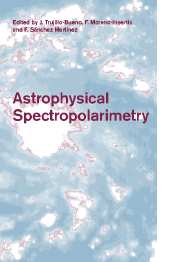Book contents
- Frontmatter
- Contents
- Participants
- Group Photograph
- Preface
- Foreword
- Acknowledgements
- The Physics of Polarization
- Polarized Radiation Diagnostics of Solar Magnetic Fields
- Polarized Radiation Diagnostics of Stellar Magnetic Fields
- Polarization Insights for Active Galactic Nuclei
- Compact Objects and Accretion Disks
- Astronomical Masers and their Polarization
- Interstellar magnetic fields and infrared-submillimeter spectropolarimetry
- Instrumentation for Astrophysical Spectropolarimetry
Polarized Radiation Diagnostics of Solar Magnetic Fields
Published online by Cambridge University Press: 21 May 2010
- Frontmatter
- Contents
- Participants
- Group Photograph
- Preface
- Foreword
- Acknowledgements
- The Physics of Polarization
- Polarized Radiation Diagnostics of Solar Magnetic Fields
- Polarized Radiation Diagnostics of Stellar Magnetic Fields
- Polarization Insights for Active Galactic Nuclei
- Compact Objects and Accretion Disks
- Astronomical Masers and their Polarization
- Interstellar magnetic fields and infrared-submillimeter spectropolarimetry
- Instrumentation for Astrophysical Spectropolarimetry
Summary
The Sun is unique as an astrophysics laboratory because we can spatially resolve its structures in great detail and apply sophisticated diagnostic techniques that require high spectral resolution. The magnetic flux in the solar atmosphere occurs in extremely fragmented, nearly fractal form, with a range of spatial scales that extend well beyond the angular resolution limit of current telescopes and into the optically thin regime. The magnetic field leaves various kinds of “fingerprints” in the polarized spectrum. In the past only the fingerprints of the Zeeman effect have been used, but more recently new, highly sensitive imaging polarimeters have given us access to other physical effects. In particular a wealth of previously unknown spectral structures due to coherent scattering processes have been uncovered. These phenomena show up in linear polarization as a new kind of spectrum (the so-called “second solar spectrum”), which bear little resemblance to the ordinary intensity spectrum. Magnetic fields modify the coherent scattering processes and produce polarized spectral signatures that greatly extend the diagnostic range of the Zeeman effect. This diagnostic window has just been opened, and we are only now beginning to develop the needed diagnostic tools and apply them to learn about previously “invisible” aspects of solar magnetic fields.
The Sun's magnetic field — An introductory overview
Role of magnetic fields in astrophysics
Most of the matter in the universe, like stars, nebulae, and interstellar matter, consists of plasma, partially ionized gas with high electrical conductivity.
- Type
- Chapter
- Information
- Astrophysical Spectropolarimetry , pp. 55 - 100Publisher: Cambridge University PressPrint publication year: 2001



